
















Glen House is the name of a series of grand resorts and hotels, dating back to 1852, in Pinkham Notch very near Mount Washington in the White Mountains of New Hampshire, USA.

















Glen House is the name of a series of grand resorts and hotels, dating back to 1852, in Pinkham Notch very near Mount Washington in the White Mountains of New Hampshire, USA.
The completion of the Grand Trunk Railway in 1851 established a route from Portland, Maine, to Gorham, New Hampshire, and brought increased visitors to the area. John Bellows converted a farmhouse into a hotel the same year and then sold it in April 1852 to J. M. Thompson, who renamed it the Glen House and finished work on its rooms. [1] Expanded by 1866, the grand hotel featured views of Mount Washington, Tuckerman Ravine, and the northern Presidential Range. Guests could visit Mount Washington on the newly opened Carriage Road (now the Mount Washington Auto Road) to its summit, visit other natural attractions in the area, or recreate in the hotel's game rooms, parlors, library, listen to an orchestra, dance, play lawn tennis, fish, play croquet, hike, horseback ride, enjoy a guided carriage ride, or take in a theater show. [2] [ self-published source? ] Guests included Albert Bierstadt, and the Bierstadt Brothers captured stereoscopic photographs of scenery in the area including a bear. John P. Soule, G. W. Woodward, Nathan W. Pease, and the Kilburn Brothers also captured stereoscopic images from the area, including mountain landscapes and other scenery as well as some of the grand hotel and its interior spaces. In 1869, Albert Bierstadt discovered hotel proprietor Col. Joseph Mariner Thompson's body down river from his sawmill following a heavy fall rainstorm. Ownership was then taken over by the Milliken brothers. This first Glen House was completely destroyed by a fire in 1884.
Rebuilt and expanded over the next few years, the second Glen House burned again in 1893 and was not rebuilt.
Property ownership was subsequently acquired by the Libby family of Gorham who converted the existing servant's quarters into the third Glen House, a 40-room hotel, that was also destroyed by fire in 1924.
In 1925, a smaller fourth Glen House was constructed, now serving winter sports enthusiasts as well as summer travelers. In March 1967, this hotel also caught fire and burned to the ground.
The fifth Glen House opened at the base of the Mount Washington Auto Road in September of 2018. [1]

Pinkham's Grant is a township in Coös County, New Hampshire, United States. The grant lies entirely within the White Mountain National Forest. As of the 2020 United States census, the population of the grant was zero.

Mount Washington is the highest peak in the Northeastern United States at 6,288.2 ft (1,916.6 m) and the most topographically prominent mountain east of the Mississippi River.
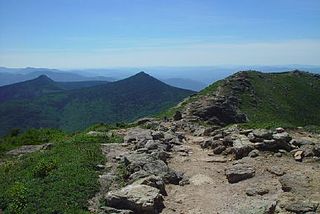
The White Mountains are a mountain range covering about a quarter of the state of New Hampshire and a small portion of western Maine in the United States. They are part of the northern Appalachian Mountains and the most rugged mountains in New England. The range is heavily visited due to its proximity to Boston and, to a lesser extent, New York City and Montreal.
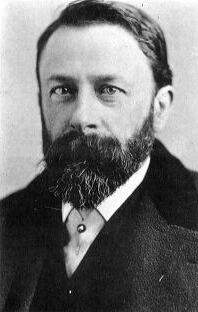
Albert Bierstadt was a German-American painter best known for his lavish, sweeping landscapes of the American West. He joined several journeys of the Westward Expansion to paint the scenes. He was not the first artist to record the sites, but he was the foremost painter of them for the remainder of the 19th century.

The White Mountains Region is a tourism region designated by the New Hampshire Division of Travel and Tourism. It is located in northern New Hampshire in the United States and is named for the White Mountains, which cover most of the region. The southern boundary of the region begins at Piermont on the west, and runs east to Campton, then on to Conway and the Maine border. The northern boundary begins at Littleton and runs east to Gorham and the Maine border. The region to the north is known as the Great North Woods Region, which should not be confused with the larger and more general Great North Woods.

The Mount Washington Hotel is a hotel in Bretton Woods, New Hampshire, near Mount Washington. It was designed by Charles Alling Gifford.

White Mountain art is the body of work created during the 19th century by over four hundred artists who painted landscape scenes of the White Mountains of New Hampshire in order to promote the region and, consequently, sell their works of art.

The Ellis River is a 16.7-mile-long (26.9 km) river in the White Mountains of New Hampshire in the United States. It is a tributary of the Saco River, which flows to the Atlantic Ocean in Maine.
The Mount Washington Auto Road — originally the Mount Washington Carriage Road — is a 7.6 mi (12.2 km) toll road in southern Coos County, New Hampshire that extends from New Hampshire Route 16 in Green's Grant, just north of Pinkham Notch, westward across Pinkham's Grant and Thompson and Meserve's Purchase to the summit of Mount Washington in the White Mountains of the US state of New Hampshire. The road climbs 4,618 ft (1,408 m) from an altitude of 1,527 ft (465 m) at the bottom to 6,145 ft (1,873 m) at the top, an average gradient of 11.6%. The road was completed and opened to the public in 1861.
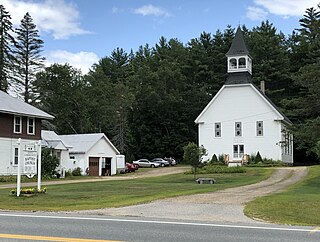
Glen is an unincorporated village in the town of Bartlett in the White Mountains of New Hampshire. The village is the home of Story Land, a popular amusement park in the Mount Washington Valley region, a resort area that also includes the communities of North Conway and Jackson.
The Mount Washington Hillclimb Auto Race, also known as the Climb to the Clouds, is a timed hillclimb auto race up the Mount Washington Auto Road to the summit of Mount Washington in New Hampshire. It is one of the oldest auto races in the country, first run on July 11 and 12, 1904, predating the Indianapolis 500 and the Pikes Peak Hill Climb. The event was revived in 2011 and was held again in 2014 and 2017.

The Tip-Top House is a historic former hotel in Mount Washington State Park in Sargent's Purchase, New Hampshire, United States. Built in 1853, it is the oldest surviving building in the summit area of Mount Washington, and is believed by the state to be the oldest extant mountain-top hostelry in the world. It features exhibits concerning the mountain's history. Located near the modern summit building and other visitor facilities, it is open for a fee to visitors from early May to early October. It was added to the National Register of Historic Places in 1982.
Mount Rosebrook is a mountain in New Hampshire's White Mountains. It is part of the Bretton Woods Ski Resort, and across from Mt. Washington Hotel.Mount Rosebrook is 3,004 feet tall.

Gorham is a town in Coös County, New Hampshire, United States. The population was 2,698 at the 2020 census. Gorham is located in the White Mountains, and parts of the White Mountain National Forest are in the south and northwest. Moose Brook State Park is in the west. Tourism is a principal business. It is part of the Berlin, NH–VT Micropolitan Statistical Area.
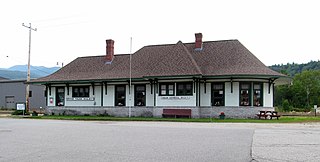
Gorham station is a former Grand Trunk Railway station in Gorham, New Hampshire, United States. It was built in 1907, long after the arrival of the railroad in 1851.

Eagle Mountain House is a historic resort hotel at 179 Carter Notch Road in Jackson, New Hampshire. Built in 1916 and enlarged in 1929, it is one of the few surviving grand mountain resort hotels in the White Mountains of New Hampshire. It was listed on the National Register of Historic Places in 1990.

Nathan W. Pease (1836–1918) was an American photographer in North Conway, New Hampshire, United States.

The Profile House was a grand hotel in the White Mountains of New Hampshire, in the United States. Originally built in 1852 and opening for its first season in 1853, it was operated by several owners and partners until its final season under the ownership of Karl P. Abbott, when the hotel, at its seasonal peak, burned to the ground, leaving only the train depot standing in the fire's aftermath. Area attractions included Franconia Notch, the Great Boulder flume, Artist's Bluff, Mount Cannon, Profile Lake, Echo Lake, and Eagle Cliff. The Profile House boasted amenities such as running water, electricity and all of the comforts to which the affluent guests had become accustomed. The hotel was named for the iconic rock structure discovered by surveyors in 1805, that came to be known as Old Man of the Mountain.
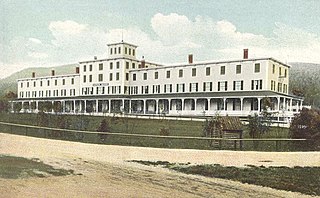
Fabyan House was a grand hotel in the White Mountains of New Hampshire, constructed by Sylvester Marsh who also built the Mount Washington Cog Railway. The hotel burned during construction in 1868 and was rebuilt in 1873. It was destroyed by fire in 1951.

The Crawford family of the White Mountains were a family who moved to New Hampshire's White Mountains in the 1790s from Guildhall, Vermont, and were pioneers in establishing a tourist industry in that area. Abel Crawford and his father-in-law, Eleazar Rosebrook, began the effort, and one of Abel's sons, Ethan Allen Crawford, made significant contributions. Another son, Thomas Jefferson Crawford, continued the work; and Ethan's wife, Lucy, also contributed. Their work was in the area then known as White Mountain Notch, subsequently called Crawford Notch.